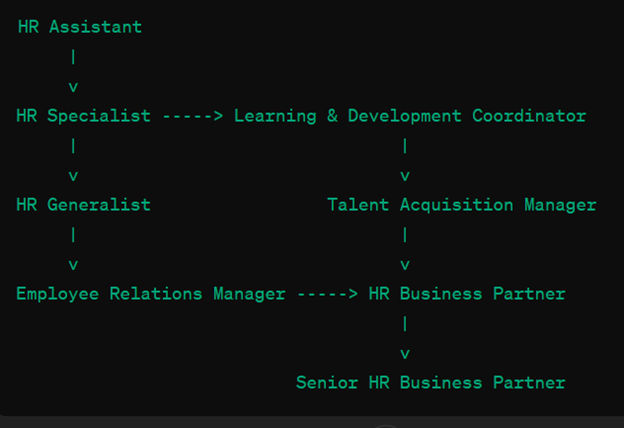Career Lattice
Summary Definition: An agile career development path that supports vertical, horizontal, and diagonal movement.
What is a Career Lattice?
A career lattice is a talent management framework that emphasizes flexible internal mobility and career development. In other words, it allows and encourages vertical, horizontal, or diagonal progression through a company.
Unlike a traditional career ladder, where employees can only move upward, a lattice pathway allows staff to explore different career options based on their personal ambitions, skills, and work-life needs. This, in turn, drives organic career development tied to personal fulfillment and satisfaction rather than status and money.
Key Takeaways
- A lattice approach modernizes the upward trajectory of a traditional career ladder by allowing for vertical, horizontal, and diagonal progression.
- Key career lattice features include individualized training, career maps, and coaching, along with opportunities for cross-training.
- A lattice career path can improve employee morale, satisfaction, and retention, as well as bottom-line revenue.
Key Features of a Career Lattice
A career lattice framework includes and supports five key features for fostering an adaptable workforce:
- Self-assessment: Self-assessment helps employees identify their strengths, weaknesses, and future career goals.
- Individualized career maps: A tailored career map can visualize a career lattice, helping employees see where they are and how they can get to where they want.
- Training and development: This might include a mixture of in-person or virtual seminars, workshops, and training courses.
- Mentorship and coaching: Mentors and coaches assigned to employees can offer guidance and support.
- Job rotation, shadowing, and cross-functional training: Insight into different company areas enables workers to discover potential new interests and enhance their skills to meet career goals.
Career Ladder vs. Career Lattice
A career ladder represents a traditional, linear progression within a single career track, with promotions and advancements occurring vertically.
In contrast, a career lattice allows for lateral or diagonal progression and development across multiple roles and functions, offering employees greater flexibility for growth.
| Career Ladder | Career Lattice |
|---|---|
|
Rigidly vertical (i.e., the only way is up.) |
Multi-directional (i.e., employees can move horizontally, diagonally, vertically, or even downward.) |
| Employees progress within their original team or department. |
Employees progress across different departments and functions. |
|
Advancement is earned via promotion after gaining a certain level of experience. |
Advancement is earned through the collection of diverse skills and experiences. |
|
The primary motivations are leadership, seniority, and a high salary. |
The primary motivation is continuous learning and development. |
|
Success is based on how high you climb the ladder. |
Success is based on personal fulfillment. |
Benefits of a Lattice Career Path
In general, by encouraging lateral movement within an organization, career lattices can help dismantle barriers between teams. This, in turn, can create multiple benefits for the organization as a whole:
- Increased employee engagement and satisfaction: Instead of being tied to one career path, employees can try new things that suit their personal goals and work-life needs. This agility boosts employee engagement and satisfaction, leading to a happier and more productive workforce.
- Improved employee retention: A career lattice retains employees by creating a flexible, personalized career path that unlocks more opportunities for growth beyond a restrictive linear trajectory.
- Attracts high-quality talent: The current workforce is attracted to companies that value flexibility, agility, learning, and development. A career lattice demonstrates an organization’s employee-centric commitment to growth, which is desirable to high-quality talent.
- Improves the bottom line: Allowing employees to expand their skills across departments creates a high-caliber workforce that can leverage a diverse skill set to exceed revenue goals.
Examples of a Career Lattice
The following examples demonstrate a career lattice in action, showcasing how individuals navigate diverse paths for career advancement and skill development:
- An experienced sales representative burns out due to their role. Instead of leaving the company, they decide to use their relationship management skills to make a lateral move to HR.
- A software developer makes a strategic internal move to a systems analyst to develop their skills before moving into an IT management or architect position.
- An entry-level marketing assistant moves into an entry-level social media position to enhance their social media knowledge. From there, they transition into an entry-level data analyst role to gain the analytical skills they need to progress into senior marketing positions
Visual Example
The diagram below illustrates how an employee may shift laterally into a different field (ex. from HR Specialist to Learning & Development Coordinator) or vertically to higher levels of authority (ex. from HR Business Partner to Senior Business Partner) in different stages of their career.


Level Up Employee Performance
Help your employees reach their full potential with modern performance management tools. From goal setting to personalized reviews and ongoing feedback, our solutions enable transparent, two-way communication and encourage employees to take ownership of their growth. Employees expect continuous development and support — give it to them with Performance Management from Paylocity.